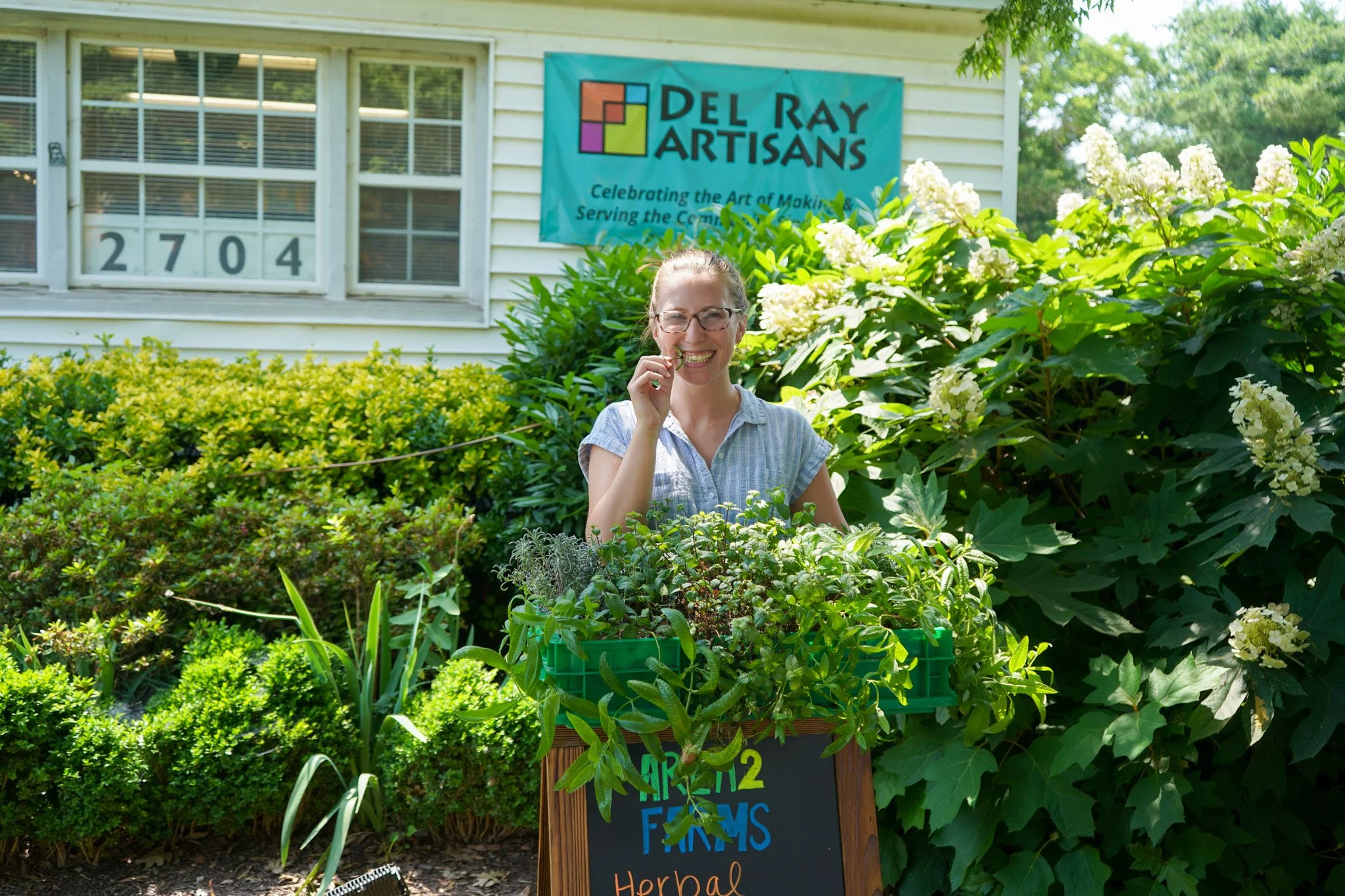A Community Experience at Georgetown Garden Shop
This summer, we teamed up with the Georgetown Garden Shop to host an herbal experience that gave neighbors a chance to taste, smell, and learn about fresh herbs. Community members sipped lavender, mint, and lemon water, harvested herbs straight from totes, and asked our farmers about our growing methods at the farm in Arlington, VA. We also talked about what makes a local agriculture system so different, and how we’re able to deliver herbs and vegetables that are just one day post-harvest.
Locally Grown Herbs are the Best Herbs
Herbs are powerful, but fragile. They don’t hold up well in storage, and they definitely don’t thrive on the 1,500-mile journey most grocery store produce takes to reach your plate. That’s why the herbs you buy at the store often wilt within a day or two.
At Area 2 Farms, we don’t have that problem. Because we grow locally, we’re able to harvest herbs like mint, tulsi, lemon balm, and lavender one day so that they are on your plate the next. And since our produce doesn’t need to survive long-distance shipping or storage, we’re free to grow all kinds of delicate, flavorful varieties you won’t usually find on grocery store shelves, like specialty herbs and edible flowers.
At the event, folks got to see what these herbs and edible flowers actually look like growing. Guests were able to harvest and taste plants they had never encountered before.
Featured Herbs from the Event:
Purple Shamrock – An edible flower with deep purple, clover-shaped leaves, and a mildly tangy, lemony flavor.
Buzz Buttons – Another edible flower with small yellow pom-pom blooms that create a tingly, electric mouthfeel.
Lavender – Silvery stems, purple spikes, and a floral and slightly sweet flavor.
Mint – An herb with bright green, serrated leaves that’s cool, crisp, and refreshing.
Lemon Balm – An herb with soft, heart-shaped green leaves, and a flavor that’s lemony with a hint of mint.
Tulsi – A basil variety that has green or purplish leaves with jagged edges, and a warm, peppery, and clove-like flavor.
Grow Your Own Herbs with Area 2 Seedlings and Soil
Lots of guests at the event wanted to know if they could grow the featured herbs at home. Yes, you can! And it starts with the right soil. We now offer Area 2 Farms’ soil mix and seedlings at the Georgetown Garden Shop. It’s the same soil we use to grow everything from microgreens to carrots on our farm. Our soil expert, Tex, built this blend to give plants the ideal balance of drainage, structure, and fertility.
What’s in Our Soil Mix:
Coconut coir – Holds moisture while letting roots breathe
Composted plant material – From our own harvest leftovers
Our transplant potting mix – Supports early-stage growth
Beneficial bacteria & fungi – Helps plants thrive naturally
Herb-Growing Tips from Your Farmers
Now that you have the right foundation, here are some tips from our farmers on how to best grow herbs in your garden.
Lavender
Full sun is key – Lavender thrives in at least 6–8 hours of direct sunlight.
Well-draining soil – Use sandy or rocky soil; lavender hates wet roots.
Go easy on water – Water deeply but infrequently once established.
Prune yearly – Cut back about one-third of the plant in early spring to keep it tidy and encourage new growth.
Give it space – Good air circulation helps prevent mildew and root rot.
Mint
Grow in a container – Mint spreads aggressively! Use a pot to keep it from taking over.
Partial sun is best – Mint likes morning sun and afternoon shade.
Keep soil moist – Water regularly, but don’t let the soil get soggy.
Pinch often – Regularly pinch back the stems to encourage bushier growth.
Cut it back – Trim it down if it gets leggy or starts to flower; it’ll bounce back fast.
Tulsi
Full sun lover – Needs 6–8 hours of sunlight daily for best growth.
Warmth is essential – Tulsi thrives in heat; don’t plant until nights stay above 50°F (10°C).
Moist, well-drained soil – Keep the soil consistently moist but not soggy.
Water consistently – Keep the soil evenly moist, but not soggy.
Pinch early and often – Regular pinching encourages bushiness and delays flowering.
Lemon Balm
Partial shade or full sun – It does well in both, but prefers some afternoon shade in hot climates.
Moist, well-drained soil – Keep the soil consistently moist but not soggy.
Grow in a container – Like mint, it spreads easily and can become invasive.
Pinch and prune regularly – This keeps it bushy and prevents flowering (which makes the leaves bitter).
Harvest often – Pick leaves regularly to encourage fresh growth and best flavor.
Cut back midseason – If it gets leggy or starts to flower, trim it down by half—it’ll regrow quickly.
Interested in Area 2 Farms’ Events?
If you’re interested in hosting an Herbal Experience at your business, home, or anywhere else, please contact us.
We host farm tours every month, along with special events throughout the year.














